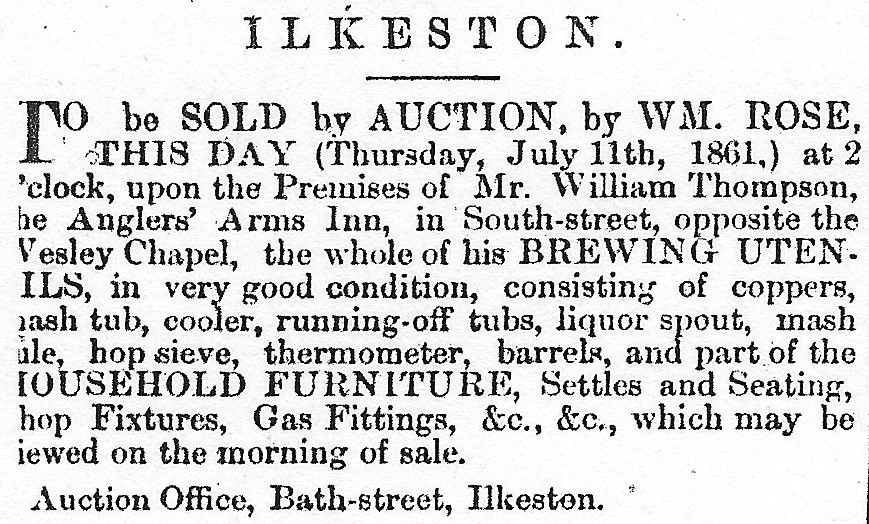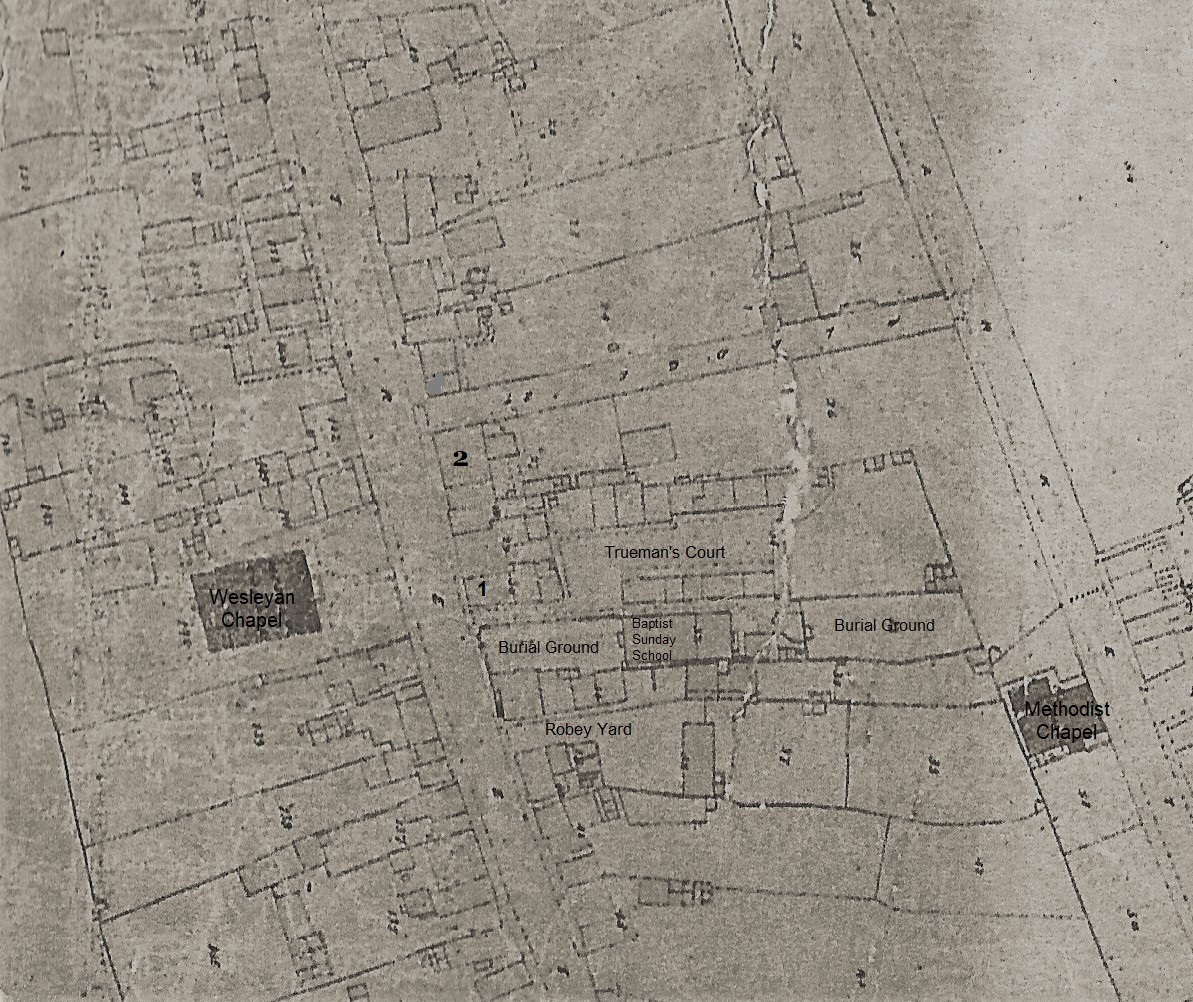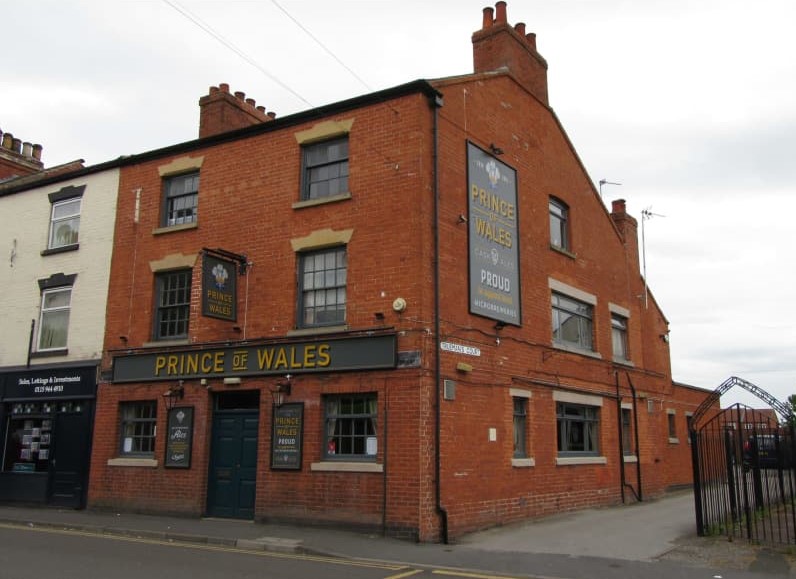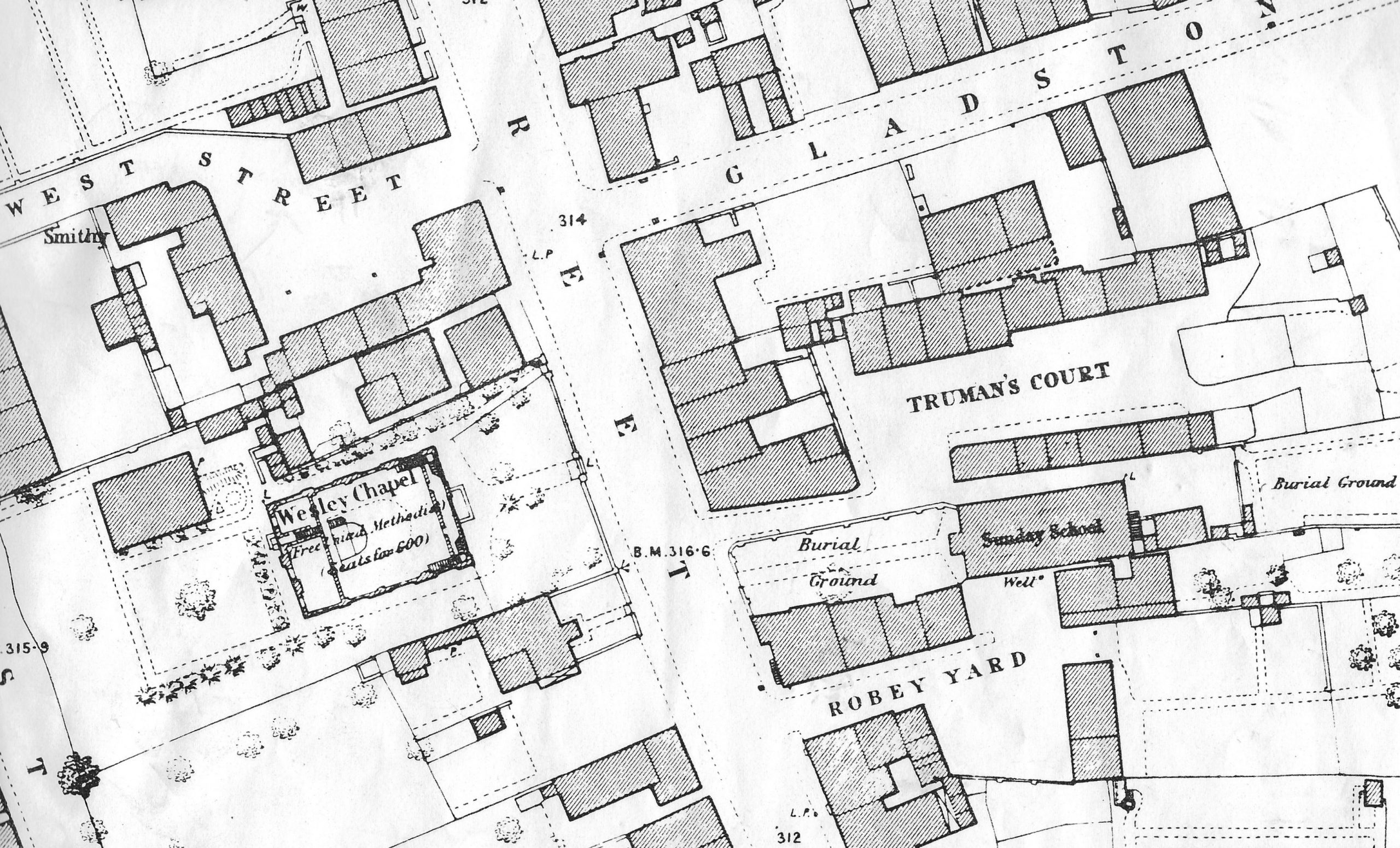Adeline describes this part of East Street: “At the side of the old Baptist Chapel, at the back of the shops, was a yard with cottages in it.” (This was Trueman’s – or Truman’s — Court.)
“(The next shops were very seldom let.) The Prince of Wales, opposite the United Methodist Free Church in South Street, had for landlord Mr. Godber. The public house and shops were as now. The tenants were very fickle and did not stay long in them.”
Here is a map of this part of South Street (which you can see running from top left to bottom middle), adapted from the Local Board Map of 1866.
Number 1 on the map is the Jolly Anglers’ Arms, later the Prince of Wales (and the Poacher in 2020).
Number 2 on the map is the premises of John Moss which we will shortly visit.
In May, throughout June and into July of 1861, the Jolly Anglers’ Arms in South Street, adjacent to the Baptist Chapel Yard and opposite the Wesley Chapel, was offered for let.
Then in July an auction at the Anglers’ Arms was held when William Thompson sold all of his brewing utensils — coppers, mash tub, cooler, running-off tubs, liquor spout, mash pale, hop sieve, thermometer, barrels, as well as household furniture seating, shop fixtures gas fittings etc. William and family were leaving town.

William’s main trade was as a rope and twine maker, and he may well have made fishing line too — hence the name of the inn ?
Was this the time that his neighbour Edwin Godber took over the beerhouse – and renamed it the Prince of Wales ?
Edwin Godber was born at Barton under Needwood in Staffordshire in 1829, the son of gardener Matthew and Naomi (nee Butters).
The 1851 census finds him working as a gardener at Shipley Hall and on Christmas Day of that year he married Mary Ann Trueman of Mapperley, daughter of joiner and wheelwright Elijah and Ann. The couple lived in South Street where Edwin kept a grocer’s shop, but still practised as a gardener there, at least into the late 1860‘s.
White’s Directory of 1865 lists him as a beerhouse keeper in South Street as does the Harrod and Co. Directory of 1870.
“After his death Mrs. Godber became landlady.”
Edwin died on January 9th, 1871 and the census of that year records Mary Ann now as keeper of the beerhouse with son John Thomas as helper — the license was transferred in February 1871. Younger son Albert Edwin is also there but third son Arthur Matthew had died in September 1866, aged one year. This was then number 21 South Street.
Mary Ann was still the beerhouse keeper when she married her second husband, Beeston-born joiner George Bark, in September 1873, and the couple stayed there until 1883 (at least?)
When up for sale in 1876 the premises were described as an old and well-accustomed beerhouse, having a bar, tap-room, parlour, good cellars, brew house, pantry, storerooms, four bedrooms, two attics, a back yard and appurtenances.
Prince of Wales at 69 South Street, and Trueman’s Court entrance to the left
At the same time as the beerhouse’s sale, 13 dwelling houses at its rear, in Trueman’s Court, were offered for sale. All properties were Copyhold of the Manor of Ilkeston.
In 1888 the beerhouse was occupied by Henry Bostock but in January 1889 the licence was transferred to Eli Barrett. The premises were then number 73 South Street. And Eli was still there in 1894 when he was sued by Ilkeston Corporation. His son had been admitted to the town’s sanatorium for 54 days and the Council was suing for his maintenance costs o £8 2s during that period. Eli was reluctant to pay but the County Court judge decided that it was a matter of common law that the beerhouse keeper should pay … and so, pay he did !!
In February 1900 the beerhouse was once more up for sale and still occupied by Eli Barrett. It had a bar, tap room, beer parlour, sitting room, kitchen. four bedrooms and, naturally, excellent cellars. An added attraction was the sale shop of Nahum Ironmonger, shoemaker, attached to it, at 71 South Street and land behind it. At the sale the pub and the adjoining land were bought by Eli the landlord for £3330.
At the same time as the inn was sold the neighbouring property of numbers 67 and 69 South Street, as well as twelve houses in Trueman’s Court and land around them was up for auction. The whole of this property was formerly copyhold of the Manor of Ilkeston but had been enfranchised in 1895. Most of the houses in the Court were purchased by Councillor Isaiah Fisher of Granby Villa.
——————————————————————————————————————————————————–
——————————————————————————————————————————————————–
Trueman’s Court
At the rear of the beerhouse was Trueman’s Court, an open yard on either side of which, north and south, was a total of about 13 households.
Earlier known as Baptist (Chapel) Yard, the area had a strong Irish representation from the 1850’s onwards and its name seems to have been derived from coalminer Samuel Trueman, born in 1825 to William and Mary (nee Webster). He lived all of his adult life here, initially with his widowed mother and then joined by Martha Farnsworth.
The couple had at least eight illegitimate children, registered as Farnsworth though several baptised as Trueman, before Samuel and Martha married in 1873.
Samuel died in 1900 at 6 Trueman’s Court, at the (registered) age of 68!!
By the time that their last child John was born in 1876, their eldest child Emma had given birth to at least seven illegitimate children, most (if not all) of them while living at Mount Row with Irish coalminer James Davis.
Here is the same area as that shown in the top map, but this time, about 1880. Notice that Pledge Street has changed its name to Gladstone Street.
Post script; part of Truman’s Court (sic) exists today (September 2021). It consists of the two most westerly semi-detached cottages of the north side, on the 1881 map above.
1900: A military funeral
On the afternoon of Tuesday, May 1st 1900, a large crowd assembled at Stanton Road Cemetery to witness the burial of Corporal John Carty. Born in Lancashire in 1863, son of Irish parents, living in Ilkeston when he joined the Derbyshire Regiment 13 years previous, he died at Normanton Barracks on April 28th, from pneumonia.
John’s body had been brought to his family home in Trueman’s Court and from there his coffin, draped in the Union Jack, was escorted to the Roman Catholic Church in Regent Street where a service was held. All the time his helmet and accoutrements lay on his coffin. Then, the short journey to the cemetery. There another short ceremony, conducted by the Rev. Canon McCarthy, was joined by a firing party of 16 of his regimental comrades. The casket of English elm, with a brass plate bearing the inscription “John Carty, at rest, April 28th 1900: aged 36 years“, was lowered into the ground. After the interment volleys were fired over the grave and the buglers blew the last farewell.
——————————————————————————————————————————————————–
Let’s walk on to meet John Moss




